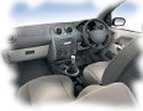The cockpit drill
A good cockpit routine, or pre-start check is as essential for an advanced driver as it is for a learner; it is impossible to drive to a high standard if, for example, your seat is poorly adjusted.
As an experienced driver you probably know when you are comfortable in the car, however, it's amazing how many drivers suffer aches and pains because of a poor driving position; these aches and pains can lead to excessive fatigue, especially on long journeys.
Getting into the habit of following a routine similar to those in this unit every time you get into your car - and before you start the engine - will help to ensure your safety and the safety of others.
Simple routines
The first routine is easily remembered as 'DSSSM' (D Triple S, M) and is probably the most widely used cockpit routine and the one that we include in the SmartDriving Visual Teaching System and on the DriverActive web site; while it does not comprehensively cover all aspects of a pre-start check it is a simple reminder to make your check before you start moving – not as you are driving along the road!
- Doors
- Seat (+ Head restraint)
- Steering
- Seatbelts
- Mirrors
The order in which checks are done is not really very important, although it can be a good idea to check the parking brake when you first get into the car – especially in hilly areas.
The reason that it is presented in the order of DSSSM (d treble s m) is simply because the letters can act as a memory trigger for new drivers, ensuring that they complete each part of the routine.
Read about DSSSM on the DriverActive site - this is the method that you will most likely use during you exam and with you pupils - however, for this section we want you to try a different routine - shown on the right.
If you have not already done so, print and complete your Training Outcomes Worksheet for this unit.
The following pages take you through the routine.
Next: Step 2 - Securing the car.
Alternative to DSSM - 'Secure - Seating - Surely - Helps - Safer - Motoring'
 The initial capital letters stand for:
The initial capital letters stand for:
- Secure the car
- Seat position
- Steering position
- Head restraint
- Seatbelts
- Mirrors
The reason for using a drill is simply to make your actions second nature. By getting used to a methodical drill you will be more aware of your pupil's actions and notice any errors when they do their pre-start checks.